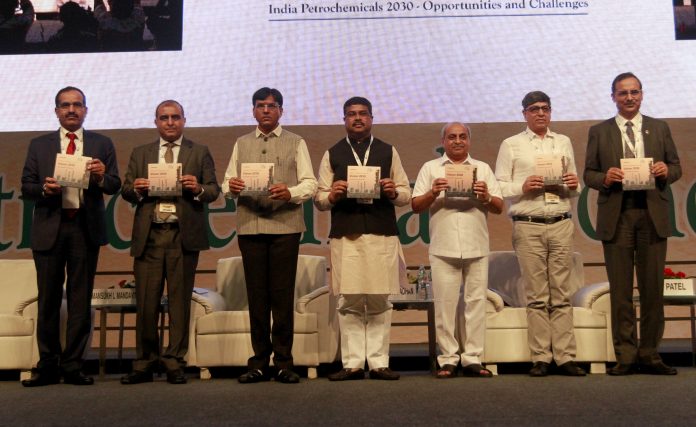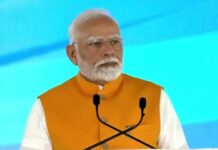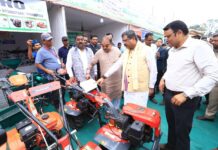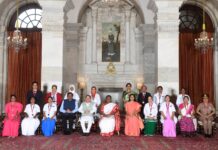
By Our Correspondent
GANDHINAGAR:The Government of India is planning to set up petrochemical clusters, in Eastern, Western and Southern India to spur the growth of the sector with a view to meeting the increasing demand for polymers/plastics and speciality chemicals across diverse industrial segments.
This was disclosed by Dharmendra Pradhan, Minister of State (Independent Charge) for Petroleum & Natural Gas, Govt. of India, while inaugurating the 6th edition of the Petrochemicals Conclave here on Saturday in the august presence of Mansukh L Mandaviya, Minister of State for Chemicals & Fertilisers, Govt. of India; and Nitin Patel, Deputy Chief Minister of Gujarat. Over 70 global companies and about 800 delegates from India and abroad are participating in the Conclave.
Addressing the gathering, Pradhan said that the petrochemicals sector is contributing in a big way to all major sectors such as agriculture, infrastructure, healthcare, textiles, consumer durables and packaging, leading to robust growth of the industry.
With increase in the per capita income and discretionary spending, there has been a steady change in spending patterns, from products made of metals to those made of fibres and plastics, which are both economical and long-lasting,” he said.
While India’s per capita consumption of plastics (polymers) is significantly low at about 10 kg per person, as against the global average of about 32 kg, the country’s aggregated demand for petrochemicals stands at 38 million metric tonnes per annum (MMTPA), Pradhan said.
India has grown at nearly 14% in polymers between 2000 and 2016, and is now a 10 MMTPA market in polymers alone. Similarly, PVC has shown tremendous growth potential with above 10% growth per annum, while India’s demand for both PET and speciality chemicals is also expected to grow at 14% and above.
With the Indian refining sector in a surplus situation, large quantities of naphtha have been freed up for value addition as petrochemical products, Shri Pradhan said. With the synergy of feedstock availability, the Indian oil & gas PSUs have invested in a big way in world-scale petrochemical complexes, and continue to do so, he said.
There is a need for setting up petrochemical clusters downstream, adjacent to the refineries, that will have all the infrastructure for doing business at one place. This will create an eco-system of entrepreneurship and employment while at the same time meeting the rising demand for petrochemical intermediates and polymer/plastic products. The petrochemicals industry has the potential to make greater impact through collaboration and innovation among industry members through forums such as the Petrochemicals Conclave, he added.
Speaking on the occasion, Nitinbhai Patel, Deputy Chief Minister, Gujarat, said that petrochemicals have a big share in making Gujarat a model state with a high growth rate. Gujarat, known as the growth engine of India, is thriving because of the petrochemical industry in the State, backed by the vision of the Prime Minister of India. The annual turnover of the petrochemicals industry in Gujarat is Rs. 5 lakh crore, supporting about 500 big industries, 1,600 medium and many small industries, Shri Patel added.
Mansukh Mandaviya, Minister of State for Chemicals & Fertilisers, Govt. of India, who also spoke on the occasion, said that import substitution of certain petrochemicals is the key requirement for sustainable development of the industry in the next five to 10 years.
He urged the petrochemicals industry members to focus on effective recycling and management of plastic waste for building a positive perception on the use of plastics.
Rajeev Kapoor, Secretary, Chemicals & Petrochemicals, Govt. of India, highlighted that the petrochemicals industry is contributing in a big way to three major initiatives of the Government of India, that is, Make In India, Skill India and Swachh Bharat. State-of-the-art R&D and speciality products will pave the way for the future growth of the sector, he added.
Earlier, welcoming the gathering,Sanjiv Singh, Chairman, IndianOil, said that India is moving towards self-reliance in the petrochemicals sector.
The proposed 60-million metric tonnes per annum (MMTPA) west coast refinery-cum-petrochemical complex is a huge initiative by India to become a major manufacturing hub for petroleum and petrochemical products, comparable to international hubs like Houston, Jurong Island, Antwerp, Shanghai and Rotterdam, he added. Avinash Joshi, Managing Director, ONGC Petroadditions Ltd. (OPaL)
The current petrochemicals market in India is estimated to be about 30 MMT per annum. The average domestic per capita consumption of petrochemicals is about 22 kg/person and the average domestic per capita consumption of Polymers is about 10 kg/person.
The total petrochemicals market in India is currently valued at approximately USD 50 Billion. Driven by the rise in polymer demand, it is expected to grow at the rate of 9% annually to reach 40 MMT/annum in consumption and USD 65-70 Billion in revenues by FY20.
Out of India’s petrochemicals demand of 30 MMT per annum, the demand for Polyolefins, used in industrial packaging and household plastic products, is estimated to be around 10 MMT.
Expected to grow at a CAGR (cumulative annual growth rate) of almost 8-9%, polyolefin demand in India is expected to reach 22 MMT by the year 2026. Overall, the petrochemicals market in India is expected to grow at a CAGR of 1.5 times that of GDP in the next 10 years.
India offers many opportunities for the growth of the petrochemicals industry by way of a large and growing domestic market, low per capita polymer and synthetic fibre consumption, expertise in specialised products and availability of trained manpower.
While the per capita consumption of polymers has reached saturation levels in US and Europe, India has the advantage of high population and high economic growth projections. This should propel India’s polymer consumption to new levels in the coming years.
Complementary to ‘Make in India’ that aims to promote the 25 sectors identified for investment in manufacturing, the Government of India has also launched several progressive initiatives like Digital India, Start-Up India, Skill India, AMRUT scheme, Swachh Bharat, Pradhan Mantri Jan-Dhan Yojana, Smart Cities and Plastics Parks, which will act as growth drivers for the petrochemicals industry.
India is set to have 10 new plastics parks with an investment of Rs. 400 crore from the Centre to boost domestic production of plastics. Four of them — one each in Madhya Pradesh, Odisha, Assam and Tamil Nadu — are under implementation while six more are to come up soon, in Jharkhand, Chhattisgarh, Madhya Pradesh, Haryana, Uttarakhand and West Bengal.
The Petrochemical Conclave provides a forum for industry experts to discuss and deliberate current issues concerning the petrochemicals industry with the objective of framing ‘Petrochemicals Vision 2030: Challenges and Opportunities’ incorporating the way forward.
The previous five editions of the Conclave had the participation of the captains of the petrochemicals industry, senior Government functionaries, etc., together with delegates from across the globe and have grown into one of the most coveted forums for knowledge-sharing and networking opportunities.
The 6th edition of the Conclave proved to be an even bigger platform for meaningful exchange of ideas between the global leaders in the petrochemical and IT industries, supply chain professionals, academics, government functionaries and data collection & dissemination agencies.





























